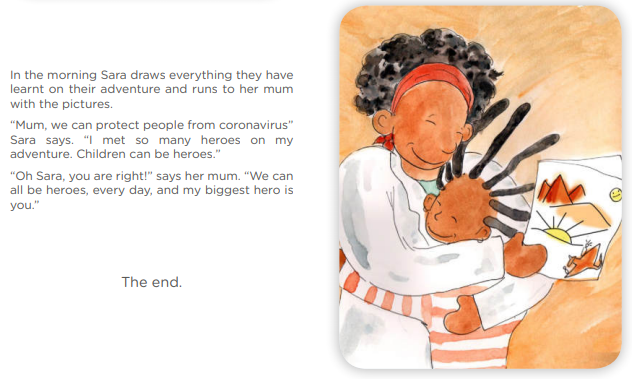
LESSON N°21
COLOR the habits that help protect our mental
health in your notebook. Follow the example:

WRITE your
interview report to the family member using the adverbs of frequency and simple
present by a mind healthy.
REMEMBER the
adverbs of frequency and the simple present:
READ these
two texts with recommendations to improve our mental health:


CHOOSE the correct answers for the following questions. Follow
the example:(RECUERDA ESTA PARTE LO RESOLVERÁS EN EL FORMULARIO SECCIÓN 1)
Which
of the following is NOT a recommendation from the text by the MHA?

1.
What does it mean to stay positive?
a.
To worry all the time. c. To
forget about all of your problems forever.
b.
To focus on the positive side of thing. d.
To smile all the time
2.
How many hours should an adult sleep every
night?
a.
Between 8 and 10 hours. c. Between 7
and 9 hours.
b.
Between 6 and 9 hours. d. At least
4 hours
3. What does Dr Lisa Damour say about anxiety?
a.
It is always good to be anxious. c. It is
dangerous to feel anxious and you should go to the doctor.
b.
It is normal to feel anxious sometimes. d. It is a disease
4.
According to Dr. Damour, how can I focus on
me?
a.
Lock yourself in your room for 3 hours. c. Learn something new.
b.
Read a book or listen to music. d. Worry about your
problems only
5.
What is the final message Dr Damour has for
teenagers?
a.
Take care of your mental and physical health.
b.
We should have a strict schedule.
c.
Forget about your problems.
d.
We should take care of our mental health and
that our families and friends are there to help us.
DO IT YOURSELF! (D.I.Y.)
CHOOSE between 4 and 5 questions
from the following boxes and interview one or two family members or friends
about their habits to take care of their mental health. Follow these steps:
How often do you connect
with friends? How
often do you eat vegetables and fruit?
How often do you support
family and Friends? How often do you learn new
things?
How often do your focus on
the positive side of situations? How
often do you feel moments of anxiety?
How often do you exercise?
1) CHOOSE your
questions.
2) INTERVIEW at least
one family member or friend. (The interview can be in Spanish).
3)WRITE your
interview report that includes the questions and answers from your family members
or friends (this report has to be in English).
About the fictional journal entry:
A. You can do it on a piece of paper, using a
pen, color pencils, pictures, glue, etc.
B. You can do it on a computer, using
Microsoft Word, Power Point or any other app of your choice.
Finally,
CREATE a video or audio of you
reading out loud your interview report.
Take into consideration the following
characteristics your report should have.
ITEMS
|
YES
|
NO
|
|
01
|
You used 4 or 5 questions from the list given for your
interview in D.I.Y.
|
||
02
|
The interview report has one sentence per each question.
|
||
03
|
Each sentence includes an adverb of frequency.
|
||
04
|
The sentences are in present simple using ‘S’, ‘ES’,
‘IES’ correctly.
|
||
05
|
The report has real information from a member of your
family.
|
LEE los dos textos otra vez. Identifica los adverbios de
frecuencia en negrita y ordénalos en la siguiente escala (de más frecuente a
menos frecuente:(RECUERDA ESTA PARTE LO RESOLVERÁS EN EL FORMULARIO SECCIÓN 2)

Ahora, escoge la
opción correcta para responder a las siguientes preguntas sobre los adverbios
de tiempo:
1.
¿En qué
partes de la oración van los adverbios de tiempo normalmente? (marca 2
respuestas)
a)
Después
del verbo “to be” c)
Al final de la oración
b) Al principio de la oración d)
Antes del verbo
principal
2.
¿Qué
palabra de pregunta o “question word” utilizamos para preguntar por la
frecuencia con la que se realizan ciertas actividades?
a)
Why c)
How often
b)
How much d) When
Observe the pictures and report what you see. Unscramble the
sentences in parenthesis. Follow the example:

3. (My niece / eats / always /vegetables /). ________________________________
4. (exercise / Marco and Ana / hardly ever). ________________________________
5. (My friend Andrés / feels /
sometimes / anxious).___________________________________
MARCA SEGÚN CREAS
CONVENIENTE:
Can I do
it?
|
Not at all
|
Somewhat
|
Well
|
Very well
|
|
01
|
Can I
identify some details in a short text in English with recommendations to
improve or protect your mental health?
|
||||
02
|
Can I
report how often a member of my family practices some habits to protect his/
her mental health in English?
|
||||
03
|
Can I
pronounce the words well and give intonation in English when I present the
report about the actions a member of my family practices to protect her
mental health?
|
QUERIDO
ESTUDIANTE RECUERDA ENVIAR TU AUDIO O VIDEO LEYENDO TU ENTREVISTA CUALQUIER
CONSULTA CON TU DOCENTE CORRESPONDIENTE:
DE LACRUZ MARTINEZ Engelsen Cel, 986532009
ZACARIAS ROSALES, Aranceli Conni Cel. 945587899
































